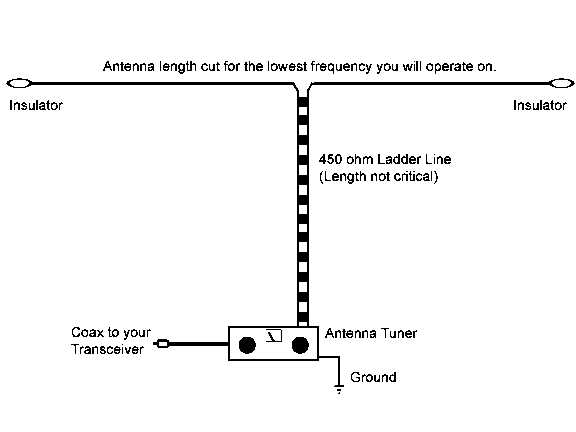450 Ohm Ladder Line
This is a type of twin lead wire used as a transmission line to carry radio energy. It is constructed of two multi-stranded copper or copperclad steel wires, held a precise distance apart by a spacer ribbon. The uniform spacing of the wires is the key to the cable's function as a parallel transmission line. If the spacing is not maintained then rf energy is reflected backwards to the transmitter.
Traditional VHF television installations from prior to the digital conversion used 300-ohm ladder line. The standard in HAM radio for HF operation is 450-ohm. This is a measurement of the impedance of the line. As a transmission line, transmission efficiency will be maximum when the impedance of the antenna, the characteristic impedance of the twin-lead line and the impedance of the equipment are the same.
- 450 Ohm Ladder Line is also known as Window Line or ladderline (one word).
- 450 Ohm Ladder Line is a type of balanced line
- Coaxial cable is a type of unbalanced line.
Coax cable has a much higher loss per unit length than open wire line or window line. For HF ham radio operation the loss of window or ladder line is so low that even at high SWR, the excess loss is rarely noticeable. So balanced line, even with a high SWR, can outperform coax which is perfectly matched.
Using Ladder Line in Ham Radio
Because balanced transmission line has relatively low loss even at high SWR, the match at the feed point is not critical for HF operation. The impedance at the input to any transmission line will be the characteristic impedance of the transmission line only when the transmission line is terminated in the line's characteristic impedance.
As long as the length of the antenna is at least a half-wavelength at its lowest intended frequency, its efficiency is well over 90% even if not well resonant. Can an antenna be a good radiator of signal if not "resonant?" The answer is "yes." When using ladder line it is important to use an antenna tuner.
Considerations
- Where to place the balun - depends on factors however the antenna tuner has a balun internally.
- Use of antenna tuner - definitely, if you plan to transmit!
- Impedance matching significance - not so important as some would preach. This isn't television!
- Ladder line radiation factor - ladder line does not radiate any appreciable amount.
- Twisting - Windowed line should be twisted about one twist for every two feet to prevent wind-induced oscillations.
Doublet Antenna -w- ladder line
An antenna tuner with a built in balun matches the feed-line impedance to the 50Ω coax of the transceiver.
